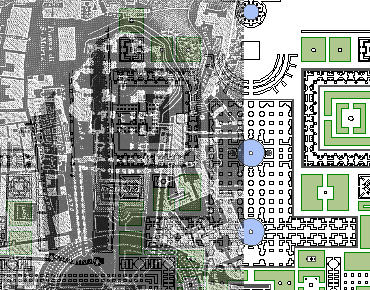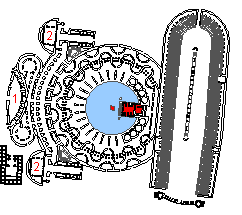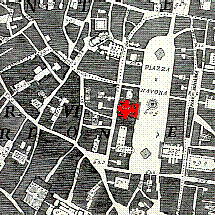Redrawing History - archeological accuracy
1997.08.16
...the Via Flamina and its odd placement in the Campo Marzio. Fasolo refers to the placement of the Via Flaminia as arbitrary. This then also brings into question the positioning of the Equiria, (which Fasolo wrongly identified as a waterway) and how the Via Flaminia today is actually the route inscribed by the Equiria of the Campo Marzio, and how the present day Corso, whose name refers to the ancient race course (I still have to verify this) is not depicted within Piranesi's Campo Marzio but the "arbitrary" Via Flaminia seems to take its place as the "main street" of the redrawing.
...note the locations in the Campo Marzio where Piranesi actually did excavation--this information is available in Lanciani's Forma Urbis Romae.
There is also the connection between the big scoop on the bank of the Tiber (depicted on the Nolli plan) and the Natatio (beach) at the same location in the Campo Marzio.
...a comparison between the Minerva Medica and the Horti Luciliani. Piranesi may be, at times, loose with what he puts where and what the buildings look like, but he is consistent in terms of finding his inspiration in actual Roman buildings.
Piranesi lives in the "Garden of Satire"
1998.07.07
...since Piranesi came to live at the top of the Spanish Steps, he may then have placed the Horti Luciliani purposefully in the same location within the Ichnographia. If this is so, then Piranesi deliberately places himself (figuratively) within the garden of the father of Roman satire. ...find the exact location of Piranesi's home, check its locationon the Nolli map, and then find the exact location within the Ichnographia. ...not sure if the exact spot will be significant, but it will be good to know nonetheless.
| |
Saint Peter's Basilica
1998.08.08
| |
The Basilican Church of Saint Peter, erected by the emperor Constantine c.330, was pulled down to make way for the present cathedral.
|
The Basilican Church of Saint Peter was erected by the emperor Constantine c.330 over the tomb of Saint Peter, which was also near Saint Peter's site of martyrdom in the Circus of Caligula and Nero. It is one of the largest imperial buildings constructed in Rome during the late years of the Empire. As such, its plan should be represented within the Ichnographia Campus Martius, however, it is not. Instead Piranesi fills the Vatican Valley with the elaborate Garden of Nero whose placement here is archeologically correct, although Piranesi's plan of the garden is entirely his own. Hence, it is easy to surmise that Piranesi simply chose to "reconstruct" this portion of ancient Rome according to its first century condition, and such a theory is plausible except that Piranesi also chose to include the Tomb of Honorius within the Garden of Nero, a sizable structure that was actually attached to Saint Peter's Basilica. The omission of Christianity's foremost shrine from the large plan therefore heralds ambiguity.

| |
St. Peter's was founded by Constantine primarily as a covered cemetery and funerary hall, serving mainly for burials, commemorative banquets, and the veneration of a martyr, the Apostle Saint Peter. Its floor was covered with graves; funerary banquets were customary--Saint Augustine tells of them as late as about A.D. 400; mausolea crowded around its walls, one--S. Maria della Febbre--older than the church and surviving until the eighteenth century. St. Peter's was on an imperial estate out of town: on the shoulder of the Vatican Hill where it sloped down toward the Gardens of Nero. [The basilica] was placed on a large terrace created by filling in the pagan necropolis and the small Christian cult center therein; only the upper part of the niche, Saint Peter's memorial, remained above the floor level.
Richard Krautheimer, Rome: Profile of a City, 312-1308 (Princeton: Princton University Press, 1980), pp. 26-7.
A detail area of the Horti Neroniani with the Circus of Caligula and Nero (left) and the Porticus Neronianae (right) is superimposed with the coinciding portion of Nolli Plan of Rome.
|
Finding the location within the Ichnographia of where the Basilica of Saint Peter's should be, begins to disclose Piranesi's intent. For example, in actuality the altar of St. Peter's Basilica sits directly above Saint Peter's tomb, which is part of row of tombs, and a superimposition of the basilica's plan and the Ichnographia plainly indicates that Piranesi places a row sepulchers precisely where they ought to be. Furthermore, the basilican plan of the Porticus Neronianae is certainly a reference to the Basilica of Saint Peter's, albeit inverted. It is as if Piranesi located St. Peter's Basilica within the Ichnographia without actually delineating it. This illusory mode of operation, moreover, infuses double meaning into the buildings of the Horti Neroniani that Piranesi does draw. It therefore becomes evident that Piranesi's rendition of the Porticus Neronianae is an imaginative reminder that not only did Saint Peter suffer and die under Nero's persecution of the Christians, but that in the end it is Saint Peter, through Christ, that ultimately triumphs. There is thus no doubt that Piranesi clearly recognized the tremendous irony whereby the most hedonistic of imperial Roman gardens ultimately became Christianity's terrestrial and spiritual center.
| |
|
21 April 1999 (Rome's birthday)
1999.04.21
The path that ultimately lead me to Helena began with my learning about a deliberate connection between Piranesi's Ichnographia Campus Martius and Saint Agnes of Rome. According to ancient tradition, the first "structure" within the Campus Martius was an altar erected by Romulus in honor of his father Mars. Piranesi situates the Ara Martis within the generally accepted location of the original altar, that is, within the area between the present day Piazza Navona and the Tiber to the west. In Piranesi's plan, the altar of Mars is within a circular pool in front of a Temple of Mars and is furthermore surrounded by an extensively curvilinear porticus. Additionally, the Domus Alexandri Severus (1) flanked by two Sessorium (2) is to the west.
 
Investigating the meaning of Piranesi's Ara Martis layout, I looked to Nolli's 1748 Plan of Rome for a possible connection. I chose this approach because I had already learned that Piranesi indeed sometimes cleverly disguised links between his Ichnographia and Nolli's plan. The only potential tie between the two maps at the Ara Martis juncture is the coinciding position of the Templum Martis and the baroque church of St. Agnes on the Piazza Navona. At this point it became necessary for me to investigate the story of Saint Agnes.
Saint Agnes died in Rome circa 249 as a thirteen year old virgin and martyr. "Her riches and beauty excited the young noblemen of the first families of Rome to contend as rivals for her hand. Agnes answered them all that she had consecrated her virginity to a heavenly husband, who could not be beheld by mortal eyes. Her suitors, finding her resolution unshakable, accused her to the governor as a Christian, not doubting that threats and torments would prove more effective with one of her tender years on whom allurements could make no impression."1 As a form of torture, Agnes was sent to a brothel where her vow of virginity would be threatened and almost certainly eradicated. According to the legend, however, an angel protected Agnes while she was in the brothel, and subsequently Agnes was put to death. The traditional location of the brothel of Agnes' torture is the site of St. Agnes on the Piazza Navona. Moreover, the subsequent execution of Agnes sent shockwaves throughout both pagan and Christian Rome because the worst possible thing any Roman could do was to kill a virgin. Suddenly, and ironically, the Roman persecution of Christians took on the guise of a pagan moral dilemma.
The martyrdom of Agnes signifies a pivotal point of pagan-Christian inversion, and this inversion is precisely what Piranesi delineates within the complex of the Ara Martis. First, the co-positioning of the Templum Martis and the church of St. Agnes represents the origin of Rome itself when Mars raped the Vestal Virgin Rhea, who subsequently became mother to Romulus and Remus. Second, the emperor Alexander Severus is known for having been very interested and sympathetic towards Christianity, to the point where he seriously considered proclaiming Jesus as one of the official Roman gods as well as carving the (inverting) words "do unto others as you would have them do unto you" over the door of his house. Third, Sessorium is a direct reference to the Palatium Sessorianum, the imperial estate that became Helena's residence in Rome after 312, and soon thereafter the church of Santa Croce in Gerusalemme. It seems quite evident that Piranesi was well aware of early Christian history, including its architectural history.
Personally, I wonder whether Piranesi recognized Helena as an architect as well.
1 Herbert Thurston, S.J. and Donald Attwater, editors, "St Agnes" in Butler's Lives of the Saints (New York: P.J. Kenedy & Sons, 1956), v. 1, pp. 133-4.
|


